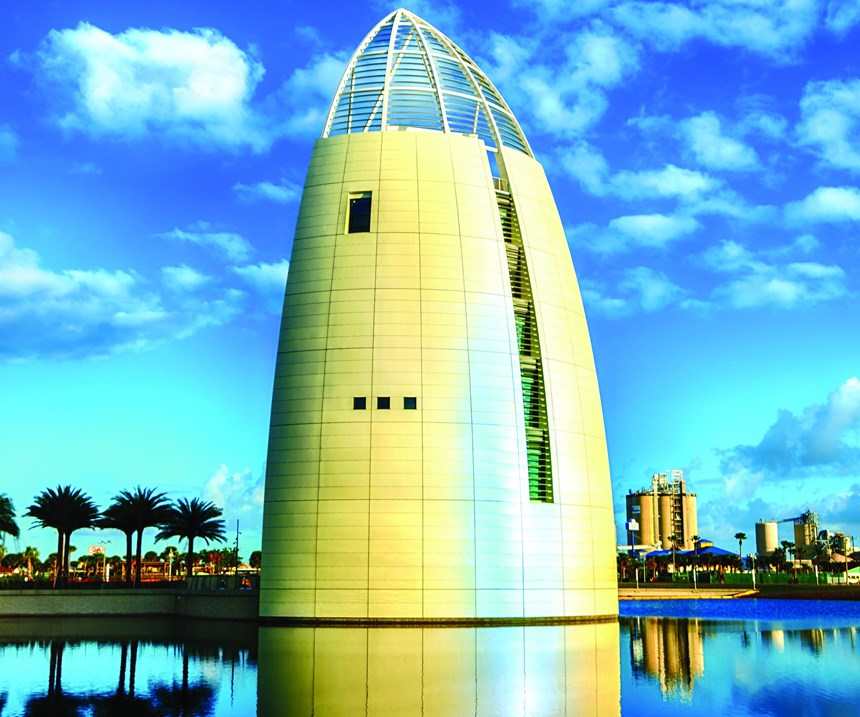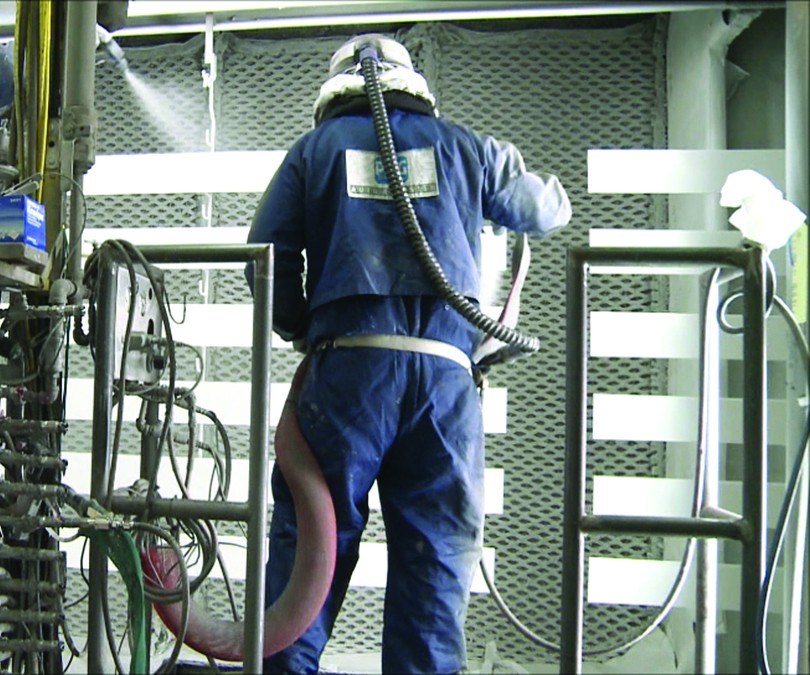Choosing the Right Finish for Coastal Projects
Aluminum architectural products are susceptible to corrosion, and proper steps must be taken to minimize its occurrence when they are located in harsh seaside and coastal regions.
Seaside and coastal areas can be beautiful locations for both residential and commercial buildings, but they also pose the greatest challenges for protecting any of these structures’ exterior-facing architectural elements when they are made from aluminum. Without proper precautions and finishes, corrosion to these aluminum components can damage the building envelope’s structural integrity, leading to systemic failure.
The seacoast is one of the most aggressive outdoor environments for aluminum, and Florida’s coastal regions represent the most corrosive in the continental United States (Cape Canaveral is cited as the most corrosive atmospheric environment). Corrosion rates vary from place to place and during different times at the same location, and such wide variability makes drawing definitive conclusions difficult. However, considered to be the primary variables affecting corrosion rates near the coast are the salt content in the air, the time of wetness of the metal surfaces, the temperature of the atmosphere and the level of other atmospheric pollutants. Several other environmental factors control these variables, including distance from the ocean, elevation, wind direction, wave action, rainfall, humidity, degree of shelter and level of industrial air pollution.
Durable Finishes
Liquid coatings and anodized finishes are among the most durable finishes for exterior-facing architectural products made from aluminum. As a prominent part of the building’s exterior, the coated aluminum can add color and a design element to a project, but such coatings also can protect the building from its unsympathetic surroundings.
In selecting a coating to withstand harsh corrosive environments, one should specify either:
- the highest-performing organic paint coating that meets AAMA 2605-17a, Voluntary Specification, Performance Requirements and Test Procedures for Superior Performing Organic Coatings on Aluminum Extrusions and Panels or
- a Class I anodize coating that meets AAMA 611-14, Voluntary Specification for Anodized Architectural Aluminum.
These two options continue to set the highest standard for architectural coatings in these types of environments, including along the seacoast.
Liquid Coatings
High-performance, 70-percent polyvinylidene fluoride (PVDF) coatings are available in virtually any conceivable color or combination of colors, and the carbon-fluorine bond used in this type of coating is commonly known to be one of the strongest. These coatings can shield buildings against weathering, pollution and aging, and they can withstand enduring and intense ultraviolet radiation, which supports their long-term color and gloss retention, and chalk-resistance.
The first defense against paint failure on aluminum is proper pretreatment of the substrate. In fact, paint is designed to be applied over clean metal that has been properly pretreated. Without such proper pretreatment, premature failure of the finish is almost guaranteed. When the target is aluminum building components to be used in severely corrosive or coastal environments, pretreatment is crucial.
The most time-tested, proven pretreatment for aluminum architectural products is a chrome phosphate conversion coating. Application of these coatings conforms to Type B, Method 5 of ASTM D1730-09 (Reapproved 2014), Standard Practices for Preparation of Aluminum and Aluminum-Alloy Surfaces for Painting, as required by AAMA 2605-17a. In order to meet the AAMA 2605-17a specification, 70-percent PVDF coatings are subject to rigorous testing performance standards, including more than 4,000 hours of salt spray exposure, and heat- and humidity resistance requirements.
Offering the longest life cycle and true sustainability, chrome phosphate conversion coatings continue to be recognized by world-class coating manufacturers as the most effective, robust pretreatments for aluminum. As a result, aluminum products installed along a seacoast or in other harsh industrial environments that do not include a chrome pretreatment may not by covered under a warranty, or the warranty length and coverage could be compromised.
Special Considerations
The shape and machining of aluminum architectural products also may facilitate or deter corrosion. For example:
- Machined holes and cut ends of factory-finished aluminum components may be protected by thin, naturally forming aluminum oxide. This oxide, while tenacious in its bond to the underlying aluminum substrate, may be susceptible to attack from strong cleaners or heavy salt deposits.
- Hems and seams on aluminum components may be formed in a way that will collect sand. With movement over time, this sand can erode away the paint coating or anodized finish.
- The shape of components may include areas that hold pooling or ponding water. These areas often can be susceptible to corrosion.
- Specific to the aluminum framing of curtain walls and window systems, weeps must be large enough to avoid becoming plugged by salt deposits.
Anodizing
When the aluminum building components must be extremely hard, such as when they will be used in high-traffic areas like entranceways and on railings, an anodized finish should be specified to meet AAMA 611-14. The hardness of anodized aluminum rivals that of diamond (on the Moh scale of mineral hardness, a diamond rates a 10 and anodized aluminum a 9).
Architectural anodizing is specified for its natural beauty, but also for its long life and low maintenance. It provides excellent wear and abrasion resistance, and requires minimal maintenance in most environments. It resists the ravages of time, temperature, corrosion, humidity and warping.
Anodized aluminum should meet the strict guidelines of the Class I specifications of AAMA 611-14, including having a minimum oxide coating thickness of 0.018 mm (0.7 mil), a minimum of 10 years color retention on the South Florida on-fence testing site and 3,000 hours corrosion resistance.
Cleaning and Maintenance
Studies have shown that increasing levels of atmospheric pollution can have a negative effect on the longevity of finishes in the absence of periodic maintenance. Runoff from adjacent site materials must be considered in any corrosion prevention plan. For example, mortar, cement and even gypsum dust can accumulate as alkaline deposits on aluminum surfaces and must be promptly rinsed away. This is especially true for mill-finish or anodized surfaces. While somewhat more resistant to alkaline attack than anodized surfaces, high-performance paint finishes can be damaged by rough attempts to remove such buildup. AAMA 609 and 610-15, Cleaning and Maintenance Guide for Architecturally Finished Aluminum, and AAMA CW 10-15, Care and Handling of Architectural Aluminum from Shop to Site, are general guides for these precautions and cleaning activities.
The susceptibility to corrosion of aluminum architectural materials is a fact that must be recognized, and proper steps must be taken to minimize the potential for its occurrence. With the considerations and preventive measures described here in place, finished architectural aluminum can retain its intended look and have long life, while providing the desired performance even in the harshest environments, including the highly corrosive seacoast. These qualities decrease the need to replace materials and components, conserve resources, optimize labor, and save money.
Related Content
Masking Solutions Provider CFS Dramatically Expands Capabilities and Capacity
Custom Fabrication & Supplies (CFS) completed a new plant expansion packing 10 times the capacity into twice the space. It dramatically enhances the supplier’s custom capabilities to provide extremely precise and cost-effective masking solutions.
Read MoreFinishing Systems Provider Celebrates 150 Years, Looks to Future
From humble beginnings as an Indiana-based tin shop, Koch Finishing Systems has evolved into one of the most trusted finishing equipment providers in the industry.
Read MoreProducts Finishing Reveals 2024 Qualifying Top Shops
PF reveals the qualifying shops in its annual Top Shops Benchmarking Survey — a program designed to offer shops insights into their overall performance in the industry.
Read MoreConveyors and Paint Systems
Choosing the right conveyor system, coating technology, and ancillary equipment.
Read MoreRead Next
Education Bringing Cleaning to Machining
Debuting new speakers and cleaning technology content during this half-day workshop co-located with IMTS 2024.
Read MoreA ‘Clean’ Agenda Offers Unique Presentations in Chicago
The 2024 Parts Cleaning Conference, co-located with the International Manufacturing Technology Show, includes presentations by several speakers who are new to the conference and topics that have not been covered in past editions of this event.
Read MoreDelivering Increased Benefits to Greenhouse Films
Baystar's Borstar technology is helping customers deliver better, more reliable production methods to greenhouse agriculture.
Read More

























